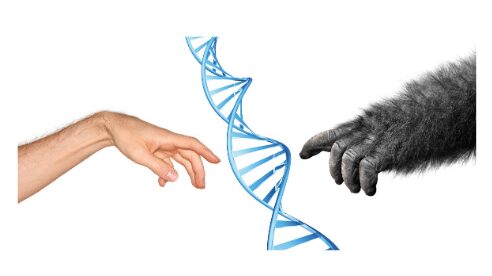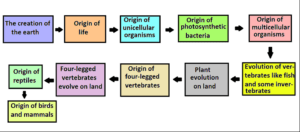
Introduction
The discussion of heredity and evolution began in the mid-eighteenth century. Charles Darwin and Gregor Mendel were the first to describe evolution and heredity. Evolution and heredity have been recognized as an important branch of biology since the mid-eighteenth century. There are some branches of science that discuss the structure, function and genetic transmission of genes. These branches are called genetics.
The gene is the basic unit of heredity. Heredity refers to the process of transmitting genetic traits from one generation to another. All of the traits that are successfully adapted to the environment among the various species survive and produce descendants. On the other hand, organisms that fail to adapt to the environment gradually become extinct. Organisms that have successfully adapted to the environment gradually evolve into new species. This is called evolution. Heredity and evolution are related to each other. Some information on heredity and evolution is described in detail below (1).
Heredity
Parental traits are passed on to children. The genetic traits of a child’s body are inherited from his parents. After the child is born, some similarities can be found between the new member of the family and another member of the same family. All of these traits are hereditary traits. Heredity is basically certain traits and genetic traits are passed down from one generation to another. Genes determine a person’s appearance, intelligence, hair color, and so on. So, the family traits that run through a person’s bloodline are known as heredity.
Heredity is controlled by genes. Modern medical research has shown that certain diseases are inherited in the human body. Children inherit DNA-containing genes from their parents, and some traits of the parents may be present in the next generation (2).
Definition
The process by which the genetic traits of an organism are transmitted from one generation to another is called heredity. It is a specific process by which the genetic traits of an organism are transmitted from parental generation to filial generation (1).
Example of heredity
Heredity controls characteristics such as eye color, skin color, blood type, and height, etc. Some diseases in humans such as color blindness, thalassemia, sickle cell anemia, haemophilia, etc. are transmitted from one generation to another due to heredity (1).
Father of heredity
For a long time, humans have been able to create new offspring with new characteristics by artificially reproducing two plants or animals of the same species with different characteristics. However, it has not been possible to discover how the hereditary traits of an organism are transmitted from one generation to the next. Gregor Johann Mendel, an Austrian clergyman, later discovered that hereditary traits are transmitted from one generation to the next through simple experiments and was able to explain that transmission. That is why Mendel is called the father of genetics (2).
Heredity factors
The factors that control the characteristics of an organism are called heredity factors. DNA (deoxyribonucleic acid) is a hereditary factor. The small part of DNA that controls traits is called a gene. The DNA of advanced organisms binds to proteins to form chromosomes. A chromosome is the bearer and carrier of heredity. And RNA (ribonucleic acid) is also another heredity factor (1).
Mendel’s laws of heredity
Mendel experimented with monohybrid reproduction and dihybrid reproduction to explain how hereditary traits are transmitted to offspring. And the formula that Mendel makes from the results of experiments on monohybrid and dihybrid reproduction is Mendel’s law or heredity law. The formula derived from monohybrid reproduction is the law of segregation. The formula derived from dihybrid reproduction is the law of independent assortment (3).
- Law of segregation
According to this formula, “a pair of opposite traits of an organism are combined when they are transmitted from one generation (parental) to another (offspring), they are never mixed. Rather, the two opposite alleles are separated during gamete formation”.
- Law of independent assortment
According to this formula, “when hybridization occurs in an organism with two or more opposite heterogeneous twin traits, the twin traits become separated from each other during gamete formation. And in the next generation, their arrangement occurs individually in all possible combinations”.
- Law of dominance
According to this formula, “when two organisms with opposite characteristics are fertilized, only the dominant trait is revealed in the first offspring, not the recessive trait”. This is Mendel’s third law of genetics. This is a subformula.
Evolution
It is a biological process that means something develops or unfolds slowly. The various species of plants and animals that are now found on the surface of the earth have evolved from pre-existing simple creatures. This theory is called the theory of organic evolution.
According to modern scientists, the earth originated from an isolated part of the sun about 4.5 billion years ago. In the first state of origin, it was a fiery furnace. The heat radiation gradually cools and creates thick clouds from water vapor. Rainfall from clouds causes water bodies. In this cloudy state, when the sun suddenly comes in contact with the basic elements like oxygen, hydrogen, etc. present in water, the protoplasm suddenly forms. From this protoplasm first unicellular plants are formed. In some cases, chlorophyll is destroyed by mutations in the body of plants, and animals are born. In this way, unicellular plants and animals gradually evolved into multicellular plants and animals, and their evolution led to the emergence of different types of plants and animals. Evolution occurs as a result of continuous change from simple organisms to complex organisms (1).
Definition
The word evolution comes from the Latin word “evolvere”, which means development.
Evolution is a slow and dynamic process that has gradually evolved from simple organisms to complex, advanced, and new types of organisms.
According to Herbert Spencer, “When a creature develops through slow but dynamic and periodic change and a particular creature changes from a simple state to a complex state, that kind of change is called evolution” (2).
Example of evolution
Organisms on earth have changed over time. For example, amphibians emerged from the fish, reptiles from amphibians, birds, and mammals from reptiles. Thus organisms are created through periodic changes. The structure and climate of the earth are changing from age to age. In keeping with that change, simple organisms have evolved according to different aspects of the natural environment. This change is still going on and will continue in the future for ages (1).
Father of evolution
Naturalist Charles Darwin is the father of evolution, whose theory of evolution has caused a stir around the world. On November 24, 1859, Darwin gave the idea of evolution in his book “On the Origin of Species by Means of Natural Selection”. This book later became known as the Origin of Species (2).
Important events in the evolution
The origin of the earth and the origin of life has been a very mysterious and complex process since the creation of civilization. Different scientists have tried to unravel this mystery at different times. The important phenomena of evolution are described below.
1. Creation of the earth
The Earth is part of the solar system. The planet is formed from parts along the relatively cool circumference of the nebula. The earth was formed about 450 to 500 million years ago.
2. Origin of life
Life originated on Earth through various chemical reactions. Scientists Oparin and Haldane gave the first idea of the chemical origin of life in the ocean.
3. Origin of unicellular organism
After the origin of life, different types of unicellular organisms gradually appeared on the earth.
4. Emergence of photosynthetic bacteria
In unicellular organisms, some photosynthetic unicellular bacteria emerge. They release oxygen into the environment through photosynthesis. This results in the emergence of free oxygen in the atmosphere.
5. Origin of multicellular organisms
Multicellular organisms originate from unicellular organisms in the course of evolution. They are relatively complex and advanced.
6. Evolution of vertebrates like fish and some invertebrates
Then, according to the laws of evolution, fish first appeared as vertebrates. And then a variety of invertebrates appeared.
7. Plant evolution on land
Although life originates in the water at first, it gradually spreads over the land. That is, new terrestrial plants originate. Plants evolve to adapt to terrestrial environments and produce plants with advanced and complex characteristics.
8. Four-legged vertebrates evolve on land
Then different animals started living on land. Mainly four-legged animals started living on land. For example, frogs begin to live in both aquatic and terrestrial environments. Thus, with the evolution of terrestrial organisms according to the theory of evolution, various superior organisms emerged (1) & (2).
The important events of evolution are described below with the help of a flow diagram

Differences between heredity and evolution
Both heredity and evolution are two biological processes. These two processes are interdependent. Heredity is necessary for evolution. However, there are some differences between heredity and evolution. Based on the above discussion the differences between heredity and evolution are described below.
Heredity |
Evolution |
| Heredity means the transfer of genetic traits. | The definition of evolution is a gradual development. |
| It is the process by which traits are passed from one generation to another. | Evolution is the process of creating simple to complex organisms through continuous change. |
| Heredity explains the process of inheriting traits from one generation to the next generation. | It explains how life evolved from a simpler to a more complex form. |
| Genetic traits are passed from parent to child. | No genetic traits are transferred in this process. |
| No new species emerge in the process of heredity. Here only genetic traits are transferred. | New species are born by the process of evolution. And the new species is complex and advanced. |
| Heredity is not dependent on time. | It is mainly a time-dependent process. Over time, a simple organism is transformed into a complex organism. |
| Heredity determines a person’s hair color, body color, blood type, height, etc. | Evolution determines the origin of complex creatures from simple creatures and the external and internal differences between the complex organisms and the previous simple organisms. |
| Heredity is controlled by genes. | Evolution is not controlled by genes. It is controlled by time. |
| Heredity discusses any trait passed from parents to children. | Evolution discusses changes in species due to the evolutionary forces of time and space (natural selection, mutation, isolation, genetic drift, hybridization, and others) (1) & (3). |
Written By: Manisha Bharati
